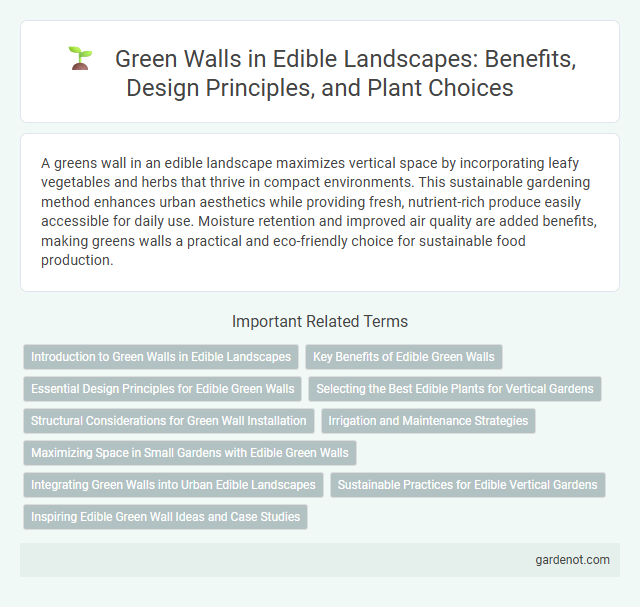A greens wall in an edible landscape maximizes vertical space by incorporating leafy vegetables and herbs that thrive in compact environments. This sustainable gardening method enhances urban aesthetics while providing fresh, nutrient-rich produce easily accessible for daily use. Moisture retention and improved air quality are added benefits, making greens walls a practical and eco-friendly choice for sustainable food production.
Introduction to Green Walls in Edible Landscapes
Green walls in edible landscapes offer vertical gardening solutions that maximize space and enhance urban food production. These living walls support a variety of edible plants such as herbs, leafy greens, and fruits, improving air quality and biodiversity in urban settings. Integrating green walls promotes sustainable agriculture by reducing soil use and boosting crop yields in limited spaces.
Key Benefits of Edible Green Walls
Edible green walls enhance urban spaces by providing fresh, nutrient-rich produce such as herbs, leafy greens, and vegetables, directly accessible for consumption. These living installations improve air quality through natural filtration, reduce urban heat island effects, and promote biodiversity by attracting pollinators. Integrating edible plants into vertical gardens maximizes limited space, supports sustainable food production, and encourages healthier dietary habits.
Essential Design Principles for Edible Green Walls
Essential design principles for edible green walls include selecting drought-tolerant, nutrient-rich plants that thrive vertically with minimal maintenance. Integrating efficient irrigation systems and lightweight, breathable growing mediums ensures optimal root health and water distribution. Strategic placement for maximum sunlight exposure boosts photosynthesis, enhancing yield and plant vitality in urban edible landscapes.
Selecting the Best Edible Plants for Vertical Gardens
Choosing the best edible plants for a greens wall involves prioritizing species with compact growth habits, high yield, and adaptability to vertical conditions. Leafy greens like lettuce, spinach, and kale thrive in vertical gardens due to their shallow root systems and fast growth. Herbs such as basil, mint, and chives also perform well, contributing both aesthetic appeal and culinary value to edible vertical landscapes.
Structural Considerations for Green Wall Installation
Structural considerations for green wall installation include ensuring the supporting framework can bear the combined weight of plants, growing medium, and irrigation systems, which often exceeds 100 pounds per square foot. The wall substrate must be moisture-resistant and durable to prevent water damage and structural deterioration over time. Proper anchoring and load distribution techniques are essential to maintain stability and safety, especially in outdoor or high-wind environments.
Irrigation and Maintenance Strategies
Effective irrigation strategies for edible green walls include drip irrigation systems that deliver water directly to the plant roots, minimizing waste and promoting healthy growth. Automated moisture sensors optimize irrigation schedules by monitoring soil hydration levels, preventing overwatering and reducing water consumption. Regular maintenance involves pruning, pest control, and nutrient supplementation to ensure vibrant plant health and sustained productivity.
Maximizing Space in Small Gardens with Edible Green Walls
Maximizing space in small gardens can be achieved through edible green walls, which transform vertical surfaces into productive growing areas. These living walls employ compact, nutrient-rich plants like herbs, leafy greens, and strawberries, optimizing limited square footage while enhancing visual appeal. Edible green walls improve air quality and biodiversity, making them an efficient solution for urban gardeners seeking sustainable food production.
Integrating Green Walls into Urban Edible Landscapes
Green walls serve as innovative solutions for urban edible landscapes by maximizing vertical space to cultivate herbs, leafy greens, and small fruiting plants. Incorporating drought-resistant and native edible species enhances sustainability while improving air quality and urban biodiversity. Maintenance practices such as automated irrigation and nutrient management systems optimize yield and support plant health in confined urban environments.
Sustainable Practices for Edible Vertical Gardens
Greens walls in edible landscapes utilize sustainable practices such as rainwater harvesting and organic composting to enhance vertical garden productivity while minimizing environmental impact. Incorporating drought-resistant, nutrient-rich plants reduces water usage and promotes biodiversity, creating resilient urban ecosystems. Utilizing recycled materials for wall structures further supports eco-friendly cultivation, ensuring long-term sustainability in edible vertical gardens.
Inspiring Edible Green Wall Ideas and Case Studies
Edible green walls transform vertical spaces into productive gardens, showcasing innovative designs with herbs, leafy greens, and edible flowers that maximize urban agriculture potential. Case studies highlight residential and commercial installations utilizing modular systems and hydroponic technology, demonstrating increased yield and aesthetic appeal. These green walls contribute to sustainable living by improving air quality, reducing urban heat, and providing fresh, home-grown produce year-round.
Greens wall Infographic

 gardenot.com
gardenot.com